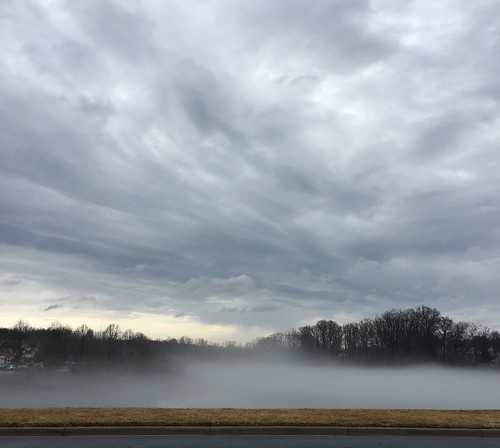Mama Joules
Family-friendly science
Friday, May 30, 2025
Lesser Celandine: The Beautiful Menace
I've been taking a Spring Wildflower class through Nature Forward, a local environmental organization here in the Washington, DC area (highly recommended, BTW, Clare Walker is an amazing teacher). As part of our class, we were sent out into the "wild" to look for native wildflowers. Well. I was very taken by this cute little yellow flower with dark green heart-shaped leaves. Lesser Celandine, as I was dismayed to learn, is not a native Maryland wildflower. It's not even a well-behaved non-native. It's highly invasive in the United States, so much so that people despise it here. Interestingly, the plant is reasonably well-controlled in its native Europe. Online opinion of this plant varies greatly depending upon what part of the world folks live in! I decided to research Lesser Celandine for my class project, and I thought I'd share my slide show with you here.
Wednesday, March 21, 2018
Spring Snow!
Today, I had the pleasure of enjoying the freak March snowstorm with my middle child, Little Brother. We were both so excited to see a decent snowfall - last winter, we barely saw any snow where we live in the suburbs of Washington, D.C.
This snow was thick and heavy, coming down on a layer of ice, and the trees were simply stunning. There’s something truly magical about driving around and hopping out of the car at random intervals to take photos, or in having your almost-teen son share his favorite park.
I wish you all a day of glitter and sparkles.
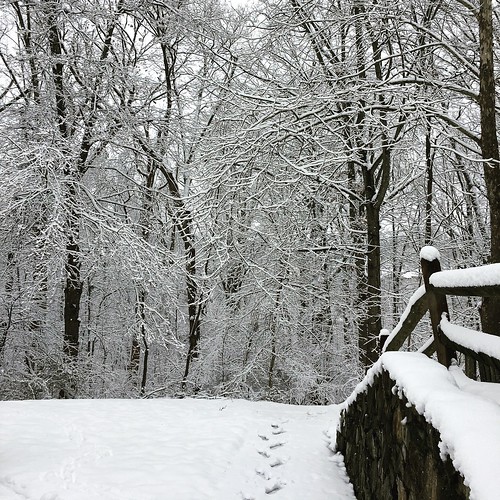
This snow was thick and heavy, coming down on a layer of ice, and the trees were simply stunning. There’s something truly magical about driving around and hopping out of the car at random intervals to take photos, or in having your almost-teen son share his favorite park.
I wish you all a day of glitter and sparkles.

Sunday, March 18, 2018
Using Crafts to Teach Science (Science Literacy Series #2)
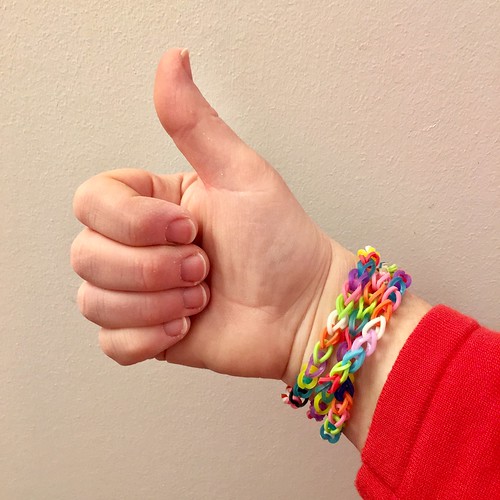
My 9-year-old daughter’s latest obsession is making jewelry from tiny, colorful rubber bands. I’m a firm believer in integrating science education into whatever subject interests a person. So, how could you approach this with crafting?
In my daughter’s case, she is a messy crafter. Her floor is currently littered with tiny rubber bands. This presents the perfect opportunity to teach about the theory of evolution, namely camouflage (Which rubber bands blend into the carpet?) and the mechanism of natural selection (Which color bands are the easiest to detect? If you were a predator, these prey would be caught first and wouldn’t have a chance to reproduce.).

Another on-ramp to science would be to discuss the rubber itself. What is rubber anyway? Is it an element? What’s the difference between natural and synthetic rubber? How was rubber first discovered? What else is made of rubber?
You don’t have to know the answers. You and your child can have fun looking them up together. This is the start of scientific inquiry. Scientific research sounds impressive, but all it really means is this: “Research conducted for the purpose of contributing towards science by the systematic collection, interpretation and evaluation of data...” - Turkish Journal of Anaesthesiology and Reanimation.
Scientists are simply curious people who keep asking questions long after others grow bored with the topic. If you can find the right hook to grab a person’s attention, you can make science relevant to (almost) anyone.
Maybe, instead of jewelry, the young crafter in your life likes to use a hot glue gun. This is a great time to talk about the states of matter. Why is the glue now more liquid than solid? What changed? You can introduce the idea that there are more than three states of matter, and that new states of matter are still being discovered!
Collecting natural materials, like pine cones, for crafting can be a nice chance to talk about the types of plants and animals that live in your community. How have they adapted to the climate in your area? For example, some pine trees have serotinous cones that are sealed with resin and require the heat of a fire to release their seeds! (Be sure to bake any pine cones you collect in a low heat oven [200 degrees F] for about 20 minutes before using them. This both kills any insects present and helps to open up the scales.)
Constructing new items out of (relatively clean) waste materials is a great opportunity to introduce the concepts of reduce, reuse & recycle. What happens to our garbage? Can we make crafts from household waste? I went to one training where we were instructed to build a bird out of paper scraps, pipe cleaners, cardboard, and small cans. The only new materials introduced were feathers, glue, and googly eyes. All of our craft birds were so different! This led to an interesting discussion about avian anatomy.
Have you ever used crafts to teach about science? Please share your thoughts in the comments!
Saturday, March 17, 2018
The (Revised) Calendar of Science Holidays
(Note from Julie: Well, Blogger and I had a falling out over my previous Calendar of Science Holidays. So, I thought I'd recreate the post here. My apologies to those kind folks who commented on the previous version and sent me new holidays. Please add your comments or any link corrections here. Thanks!)

Each year holds a wealth of weird, wacky, and interesting -- yet under-celebrated -- days for science, like World Meteorological Day and World Water Day. I decided to put together a calendar of annual science holidays and special events that celebrate science so that we could enjoy them together.
National events listed here refer to the United States, unless otherwise noted. Of course, if you live outside of the US, you are more than welcome to celebrate with us! (And I'll admit, some of these holidays are a little less "official" than others.) I expect to update this post in the future, so feel free to send me your special day and I'll add it to the list. Thanks!
* * * *
January
5 - National Bird Day
17 - Kid Inventors' Day
Last Saturday of the month - National Seed Swap Day
February
2 - World Wetlands Day
11 - National Inventors' Day
11 - International Day of Women and Girls in Science
12 - Darwin Day
mid-month - Great Backyard Bird Count (four days)
third week - National Engineers Week (includes Introduce a Girl to Engineering Day)
March
12 - National Agriculture Day
12 - Plant a Flower Day
14 - Pi Day
22 - World Water Day
23 - World Meteorological Day
on or near Spring Equinox - Sun-Earth Day
National Wildlife Week
April
12 - Yuri's Night (The World Space Party)
13 - International Plant Appreciation Day
14 - Citizen Science Day
22 - Earth Day
25 - National DNA Day
second full week - National Robotics Week
last week - National Environmental Education Week
the week of the new moon - International Dark Sky Week
Earth Month
May
4 - Star Wars Day (May the 4th be with you!)
8 - National Rain Day (Australia)
12 - National Lab Day
22 - International Day of Biodiversity
23 - World Turtle Day
third Friday - Endangered Species Day
first full week - National Wildflower Week
June
5 - World Environment Day
6 - National Butterfly Awareness Day
8 - World Oceans Day
15 - Global Wind Day
first Saturday - National Trails Day
National Pollinator Week
July
20 - Moon Day
22 - Pi Approximation Day
August
fourth Sunday - World Kitchen Garden Day
National Water Quality Month
September
12 or 13 - Day of the Programmer
14 - Protect Your Groundwater Day
18 - International Observe the Moon Night
18 - World Water Monitoring Day
25 - Nature Rocks Day
26 - World Rivers Day (Canada)
third Saturday - World Tree Day
last Saturday of the month - National Public Lands Day
24-30 Take a Child Outside Week
October
10 - Powers of Ten Day
14 - No Child Left Inside Day (date varies, part of Earth Science Week)
15 - National Fossil Day (date varies, part of Earth Science Week)
17 - Geologic Map Day (date varies, part of Earth Science Week)
20 - World Statistics Day
23 - National Mole Day (celebrating Avogadro's number)
4 - 10 World Space Week
week containing the 10th day - National Metric Week
second full week - Earth Science Week
third full week - National Chemistry Week
Waste Reduction Week (Canada)
November
10 - World Science Day (for Peace and Development)
15 - America Recycles Day
30 - Computer Security Day
December
(No listings yet.)
[Last updated - 3/17/18: Updated World Weather Day into World Meteorological Day, added Global Wind Day, International Day of Women and Girls in Science, World Science Day, International Dark Sky Week, Pi Approximation Day, Day of the Programmer; 3/16/18: Added Citizen Science Day and National DNA Day; 3/28/14: Added Star Wars Day and No Child Left Inside Day, corrected dates. 10/20/12 - Added Geologic Map Day. 1/29/11 - Added National Seed Swap Day; edited link for Sun-Earth Day. 10/4/10 - Added World Space Week. 9/17/10 - Added International Observe the Moon Night, National Metric Week. ]
Photo credit: SantaRosa OLD SKOOL via flickr // CC BY 2.0

Each year holds a wealth of weird, wacky, and interesting -- yet under-celebrated -- days for science, like World Meteorological Day and World Water Day. I decided to put together a calendar of annual science holidays and special events that celebrate science so that we could enjoy them together.
National events listed here refer to the United States, unless otherwise noted. Of course, if you live outside of the US, you are more than welcome to celebrate with us! (And I'll admit, some of these holidays are a little less "official" than others.) I expect to update this post in the future, so feel free to send me your special day and I'll add it to the list. Thanks!
* * * *
January
5 - National Bird Day
17 - Kid Inventors' Day
Last Saturday of the month - National Seed Swap Day
February
2 - World Wetlands Day
11 - National Inventors' Day
11 - International Day of Women and Girls in Science
12 - Darwin Day
mid-month - Great Backyard Bird Count (four days)
third week - National Engineers Week (includes Introduce a Girl to Engineering Day)
March
12 - National Agriculture Day
12 - Plant a Flower Day
14 - Pi Day
22 - World Water Day
23 - World Meteorological Day
on or near Spring Equinox - Sun-Earth Day
National Wildlife Week
April
12 - Yuri's Night (The World Space Party)
13 - International Plant Appreciation Day
14 - Citizen Science Day
22 - Earth Day
25 - National DNA Day
second full week - National Robotics Week
last week - National Environmental Education Week
the week of the new moon - International Dark Sky Week
Earth Month
May
4 - Star Wars Day (May the 4th be with you!)
8 - National Rain Day (Australia)
12 - National Lab Day
22 - International Day of Biodiversity
23 - World Turtle Day
third Friday - Endangered Species Day
first full week - National Wildflower Week
June
5 - World Environment Day
6 - National Butterfly Awareness Day
8 - World Oceans Day
15 - Global Wind Day
first Saturday - National Trails Day
National Pollinator Week
July
20 - Moon Day
22 - Pi Approximation Day
August
fourth Sunday - World Kitchen Garden Day
National Water Quality Month
September
12 or 13 - Day of the Programmer
14 - Protect Your Groundwater Day
18 - International Observe the Moon Night
18 - World Water Monitoring Day
25 - Nature Rocks Day
26 - World Rivers Day (Canada)
third Saturday - World Tree Day
last Saturday of the month - National Public Lands Day
24-30 Take a Child Outside Week
October
10 - Powers of Ten Day
14 - No Child Left Inside Day (date varies, part of Earth Science Week)
15 - National Fossil Day (date varies, part of Earth Science Week)
17 - Geologic Map Day (date varies, part of Earth Science Week)
20 - World Statistics Day
23 - National Mole Day (celebrating Avogadro's number)
4 - 10 World Space Week
week containing the 10th day - National Metric Week
second full week - Earth Science Week
third full week - National Chemistry Week
Waste Reduction Week (Canada)
November
10 - World Science Day (for Peace and Development)
15 - America Recycles Day
30 - Computer Security Day
December
(No listings yet.)
[Last updated - 3/17/18: Updated World Weather Day into World Meteorological Day, added Global Wind Day, International Day of Women and Girls in Science, World Science Day, International Dark Sky Week, Pi Approximation Day, Day of the Programmer; 3/16/18: Added Citizen Science Day and National DNA Day; 3/28/14: Added Star Wars Day and No Child Left Inside Day, corrected dates. 10/20/12 - Added Geologic Map Day. 1/29/11 - Added National Seed Swap Day; edited link for Sun-Earth Day. 10/4/10 - Added World Space Week. 9/17/10 - Added International Observe the Moon Night, National Metric Week. ]
Photo credit: SantaRosa OLD SKOOL via flickr // CC BY 2.0
Labels:
activities,
animals,
astronomy,
atmospheric science,
biology,
celebrations,
chemistry,
computer science,
ecology,
events,
evolution,
fun,
just for fun,
math,
mathematics,
science,
science holidays,
statistics
Thursday, March 15, 2018
Spots and Stripes: A Preschool Nature Walk
This week, for my naturalist walk at nature preschool, we talked about the two species of skunks found in Maryland: the Eastern striped skunk and the rarer, smaller Eastern spotted skunk. I brought a skunk pelt to show them, and the kids had a lot of questions.
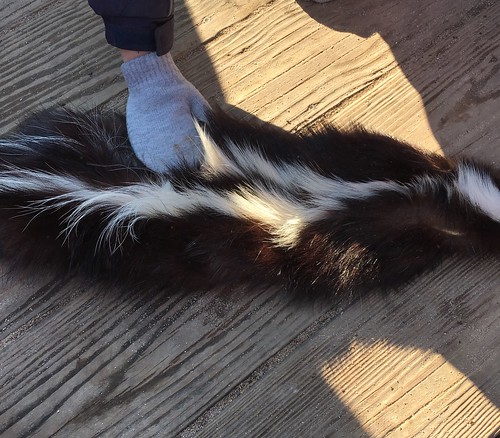
“Turn it over!”
“What’s on the other side?”
“Where’s the bones?”
Apparently, although the kids had seen animal skulls before, they’d never seen a fur. One of their teachers explained how scientists preserve pelts of dead mammals to learn more about the animals and to teach others about them.
I pointed out that skunks have warning coloration, which is the opposite of camouflage. Instead of blending into the background, their striking black and white coloration warns other animals that they are dangerous, and not to mess with them. The scientific term for this is aposematic.
In keeping with the theme of spots and stripes, I decided that we should look for these patterns while walking. Finding stripes and spots in nature at the tail end of winter in Maryland took a little work! Frankly, everything looked brown where we were walking, with a tiny pop of color here and there.

I did find spring flowers along the roadside: delicate white Snowdrops and flashy Glory of the Snow. Aren’t those great names for flowers?
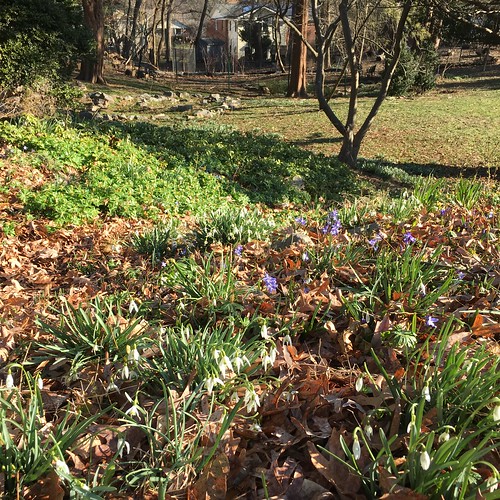
We noticed stripes in the tree rings of cut trees, along the bark of some tree trunks, and in little lines in the ice at the pond. We found spots of bird poop and in a series of tree slices.
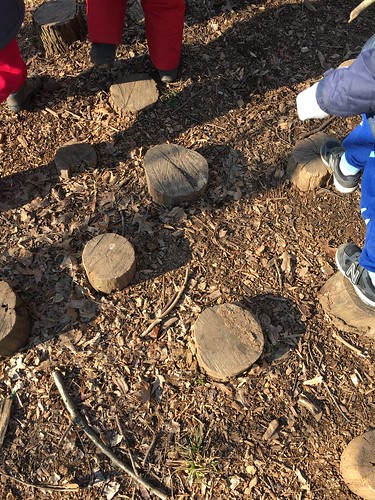
But the most exciting find came when one of the teachers rolled a rotten log** and there was a yellow-spotted salamander resting beneath it! We squealed and took pictures and one of the teachers mentioned that she was going to forward this find to another preschool class and to the scientists working at the mansion. We rolled the log back to protect the salamander. I told the kids that this was really cool because they got to be citizen scientists - everyday folks whose findings help scientists.
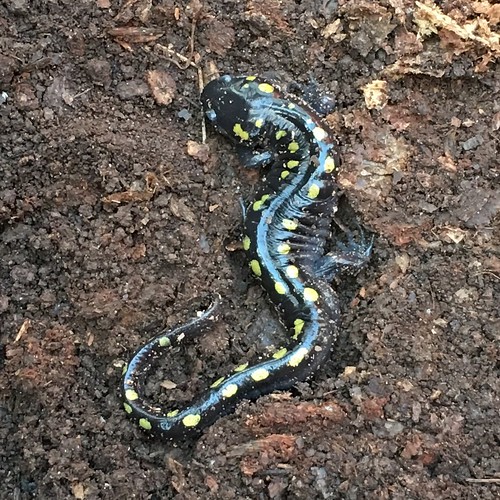
It was a great nature walk!
** Always remember to roll a log toward you, in case something underneath comes running out!

“Turn it over!”
“What’s on the other side?”
“Where’s the bones?”
Apparently, although the kids had seen animal skulls before, they’d never seen a fur. One of their teachers explained how scientists preserve pelts of dead mammals to learn more about the animals and to teach others about them.
I pointed out that skunks have warning coloration, which is the opposite of camouflage. Instead of blending into the background, their striking black and white coloration warns other animals that they are dangerous, and not to mess with them. The scientific term for this is aposematic.
In keeping with the theme of spots and stripes, I decided that we should look for these patterns while walking. Finding stripes and spots in nature at the tail end of winter in Maryland took a little work! Frankly, everything looked brown where we were walking, with a tiny pop of color here and there.

I did find spring flowers along the roadside: delicate white Snowdrops and flashy Glory of the Snow. Aren’t those great names for flowers?

We noticed stripes in the tree rings of cut trees, along the bark of some tree trunks, and in little lines in the ice at the pond. We found spots of bird poop and in a series of tree slices.

But the most exciting find came when one of the teachers rolled a rotten log** and there was a yellow-spotted salamander resting beneath it! We squealed and took pictures and one of the teachers mentioned that she was going to forward this find to another preschool class and to the scientists working at the mansion. We rolled the log back to protect the salamander. I told the kids that this was really cool because they got to be citizen scientists - everyday folks whose findings help scientists.

It was a great nature walk!
** Always remember to roll a log toward you, in case something underneath comes running out!
Wednesday, March 14, 2018
Thursday, March 8, 2018
Fun Facts About Flying Squirrels
There are two species of flying squirrels living in the forests of North America: southern and northern. They prefer forests with ample tree canopy.
Flying squirrels don’t really fly, they glide – like superheroes with a cape! Imagine you are wearing a blanket on your back, and it’s attached to your wrists and ankles. On a flying squirrel, this is called the patagium. It’s similar to gliding with a parachute. This article, in the Journal of Mammalogy, compares flying squirrels to hang gliders.
The tail of the flying squirrel has smooth fur and is horizontally flat. It is used as both a rudder and a stabilizer during glides.
Flying squirrels live in holes in trees or build nests of leaves and twigs. They have been known to use nest boxes and sometimes even kick birds out of their nest boxes while eating their eggs!
They store acorns for winter. They also eat fruit, other nuts, insects, and mushrooms.
Southern flying squirrels are about as common as the Eastern gray squirrel, but we seldom see them because flying squirrels are nocturnal. Notice the giant eyes in the photo below of a Carolina northern flying squirrel.
Photo credit: Corinne Diggins, Virginia Tech/USGS VCFWRU
The Carolina northern flying squirrel is an endangered subspecies of the northern flying squirrel. It lives at elevations 4,500 feet above sea level or higher. As of 2015, its habitat had been reduced to nine mountain peaks in the southern Appalachians. Scientists refer to these fragments of habitat as “sky-islands”.
Subscribe to:
Posts (Atom)


